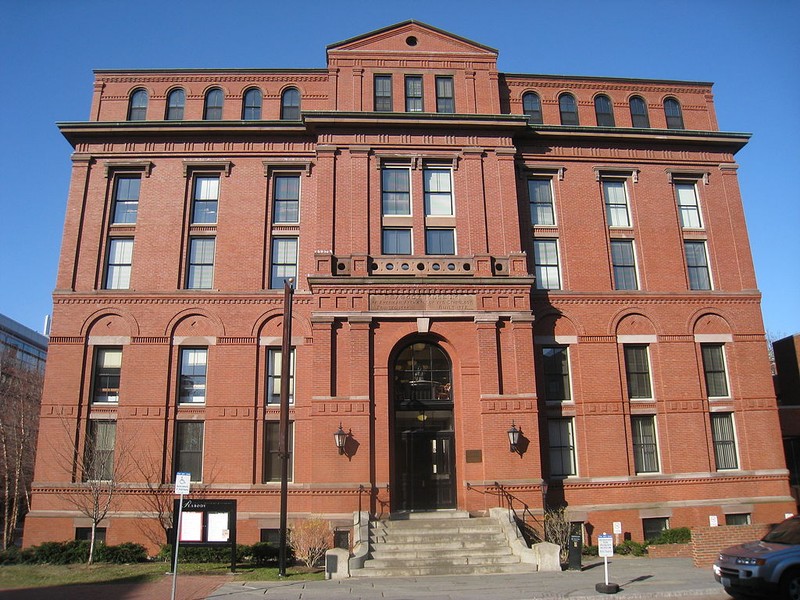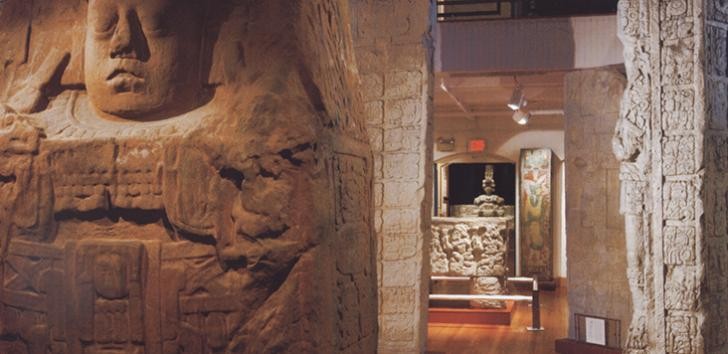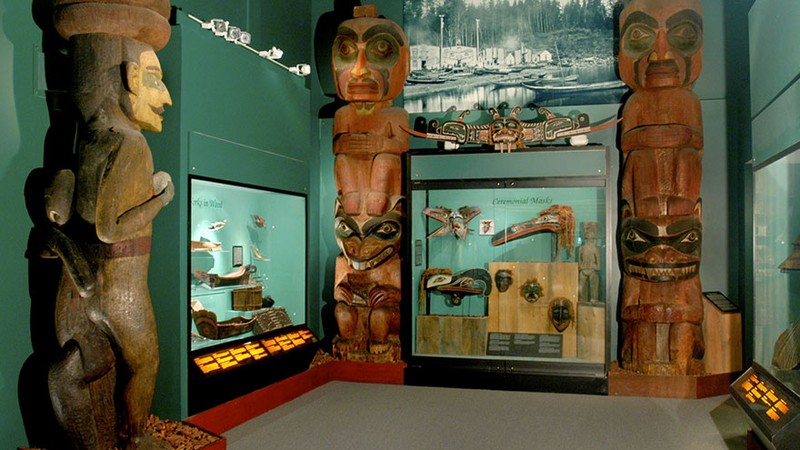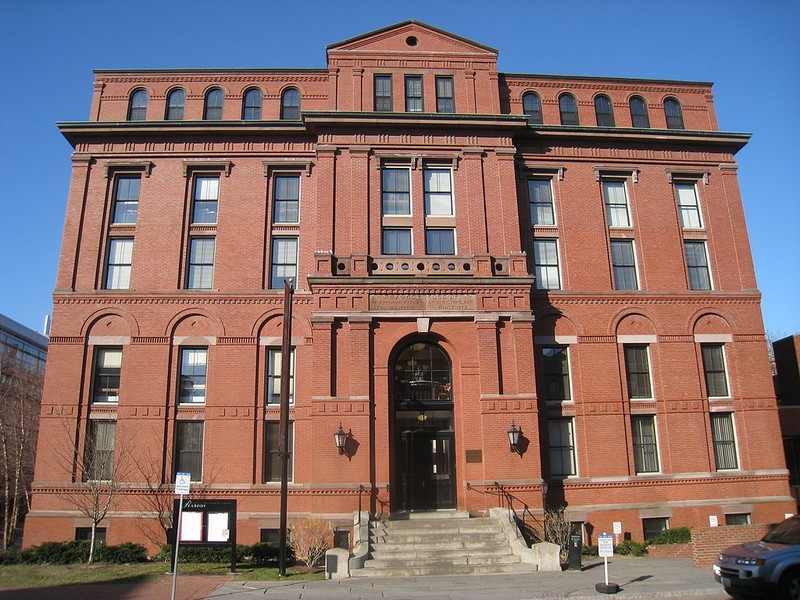Peabody Museum of Archaeology & Ethnology at Harvard University
Introduction
Author-Uploaded Audio
Listen to a narration of this entry's description by Victoria Endres.
Text-to-speech Audio
Images
The Peabody Museum (image from Wikimedia Commons)

Encounters with the Americas exhibit (image from Harvard University)

Hall of the North American Indian, ongoing exhibit at the Peabody Museum (image from Harvard University)


Backstory and Context
Author-Uploaded Audio
Listen to a narration of this entry's description by Victoria Endres.
Text-to-speech Audio
Founded in 1866 by Massachusetts-born George Peabody, Harvard University's Peabody Museum of Archaeology and Ethnology is one of the world's first anthropology museums. Its collections include archaeological and ethnological material from North, Central, and South America; Europe; Africa; Asia; and Oceania. Its materials include artifacts; photographic archives; paintings, drawings, and textiles; osteological, paleoanthropological, and zooarchaeological collections; and manuscripts, correspondence, and other historical documents.
George Peabody and the Museum
Born in South Danvers (now Peabody), Massachusetts, in 1795, George Peabody only attended school for four years as a child, due to his family's financial limitations. Nonetheless, Peabody made a fortune through international finance, and in his lifetime gave more than $10 million back in support of education and helping less fortunate members of society. Credited as the founder of modern philanthropy, Peabody helped finance twenty-two educational institutions, beginning in the 1850s, including the Peabody Museum of Archaeology and Ethnology at Harvard and the Peabody Museum of Natural History at Yale (both in 1866). A year after its founding, Harvard's Peabody Museum held its first exhibition, which consisted of its whole collection at the time: prehistoric artifacts of the Merrimack Valley of Massachusetts. The museum led expeditions and commissioned collections during the 1870s and 1880s, mainly in North and South America, expanding to global collections in the decades which followed. Original research by students and scholars using the Peabody Museum's collections helped define anthropology as an emerging discipline.
Collections of the Peabody Museum of Archaeology and Ethnology
Of the approximately 1.2 million objects in the Peabody collections, most are archaeological artifacts, though the museum's ethnographic holdings are substantial, as well. The North American archaeological collections include artifacts from Hopewell and other mound sites, Harvard Yard excavations (see Clio entry on Matthews Hall), and Arizona and New Mexico sites and collections from the Hemenway archaeological expedition and the Keam and Mimbres collections, among others. Ethnographically, North America is represented by Arctic hunting equipment and garments; Northeastern quillwork, baskets, canoes, and wampum; Lewis and Clark collections from the Plains; Louisiana Chitimacha baskets; and Southwest Pueblo ceramics. The Central American collection includes a carved mask collection from Mexico and Guatemala, and artifacts from more than thirty Maya and Aztec archaeological sites in Mexico, Honduras, and Guatemala, as well as the Corpus of Maya Hieroglyphic Inscriptions. The South American collection includes archaeological material from the Moche, Inca, Nazca, Huari, and Chimu cultures, 5,000 ancient Peruvian textiles, and ethnological material from the 1870s and 1880s Agassiz expeditions. Neolithic and Iron Age European collections include Paleolithic archaeological material from France, Germany, and Ireland, as well as the Duchess of Macklenburg Collection of Slovenian Iron Age artifacts and ethnological collections from Scandinavia and Yugoslavia. The Asian collection includes Middle Eastern, Southern, and Central Asian archaeological artifacts from Paleolithic, Mesolithic, and Neolithic periods, as well as ethnographic collections including Japanese and Middle Eastern ceramics and Ainu garments and prayer sticks. The African collections include archaeological material from Egyptian and Nubian sites, as well as musical instruments and a Liberian mask collection, and the Oceania collections include artifacts from Tasmania, Australia, New Guinea, and Easter Island.
Over eighty countries over six continents are represented in the Peabody Museum's osteological museum, including both human and non-human primate remains, fossils, and casts. At least 18,500 individuals are represented by this collection, around 40% of them from the United States. Remains include individuals from Mayan archaeological sites (Chichen Itza and Copan Valley, among others), the Juilio C. Tello collection of Peruvian crania, 400 individuals from 15th-century Yugoslavian cemetery Mistihalj, Iron Age Slovenian remains, Paleolithic remains from Mount Carmel in Israel, Predynastic to Ptolemaic Egyptian remains, and a Liberian chimpanzee cranial collection. The museum also contains a hominin cast collection in its Paleoanthropology lab and a zooarchaeological collection for the identification and study of animal remains in archaeological contexts.
The Peabody Museum holds over 500,000 photographs from the 1850s to the late twentieth century, including daguerreotypes, 35mm, and slide photography documenting expeditions and world cultures. It is one of the ten largest such archives in the world. In addition, the museum holds a small collection of 200 paintings and 950 prints and drawings. These include watercolor and oils, pencil and pen and ink drawings, dry points and pastels, etchings and engravings, lithographs, and charcoal and crayon sketches. Roughly half of these are from the David I. Bushnell, Jr. collection of American Art. The Museum Archives' paper collections comprise over 1,400 cubic feet of manuscripts, correspondence, field notes from expeditions, and more, all primary source materials related to the archaeological and ethnographic research and exhibitions undertaken by the museum.
Exhibitions
Ongoing, regular exhibitions of the Peabody Museum are Change & Continuity: Hall of the North American Indian, which focuses on European and American Indian interaction; Day of the Dead/Día de los Muertos, which explores the Aztec origins of the holiday; Digging Veritas: The Archaeology and History of the Indian College and Student Life at Colonial Harvard; Encounters with the Americas, which focuses on native cultures of Latin America before and after 1492; The Legacy of Penobscot Canoes: A View from the River a new installation focusing on the importance of rivers and canoes in Penobscot tribal life; and Wiyohpiyata: Lakota Images of the Contested West, presenting Lakota perspectives on westward expansion through art. The museum also holds special exhibitions on topics such as artistry in weapons, culture and art, musical instruments, and more. There are also over twenty online exhibitions available at the Peabody Museum website on a variety of topics from all over the world.
Sources
Peabody Museum, Peabody Museum of Archaeology and Ethnology . Accessed November 1st 2020. https://www.peabody.harvard.edu .
Watson, Rubie. Opening the Museum, Peabody Museum of Archaeology and Ethnology. 2001. Accessed November 1st 2020. https://www.peabody.harvard.edu/files/Opening_the_Museum_150dpi.pdf.
